| News / Space News |
Changing salt marsh conditions send resident microbes into dormancy
NSF | SEPTEMBER 27, 2016
Salt marshes play key roles in reducing the effects of urbanization and climate change. Marshes absorb carbon dioxide from the atmosphere, and their microbes break down carbon.

Sunset over a salt marsh at Plum Island, Massachusetts, as autumn arrives. ![]()
Jennifer Bowen of Northeastern University and colleagues have studied microbes in the sediments of salt marshes in the National Science Foundation (NSF) Plum Island Ecosystems Long-Term Ecological Research (LTER) site in northeastern Massachusetts.
They're working to discover how the marsh -- and the microbes in it -- change over time when outside influences, such as nitrogen, are introduced to the ecosystem.
Adding nutrients like nitrogen produced no change in the types of bacteria present in the salt marsh -- at least, temporarily. But over time, a large number of the microbes became dormant.
These dormant bacteria are in a low metabolic state. They just bide their time until environmental conditions return that are suitable for them.
When the microbes go dormant, they don't contribute to the critical ecosystem services that make salt marshes important.
This study shows that human activities are affecting bacteria essential to salt marshes in ways we never suspected. Coastal salt marshes provide many benefits -- supporting diverse wildlife, helping to reduce pollution, and protecting us from flooding.
The study's results help explain why salt marshes contain so much microbial diversity. One group of microbes is specialized for a specific set of conditions, while another is linked with others. As the environment changes, different bacteria take advantage of the conditions that are most suitable to them.
YOU MAY ALSO LIKE



